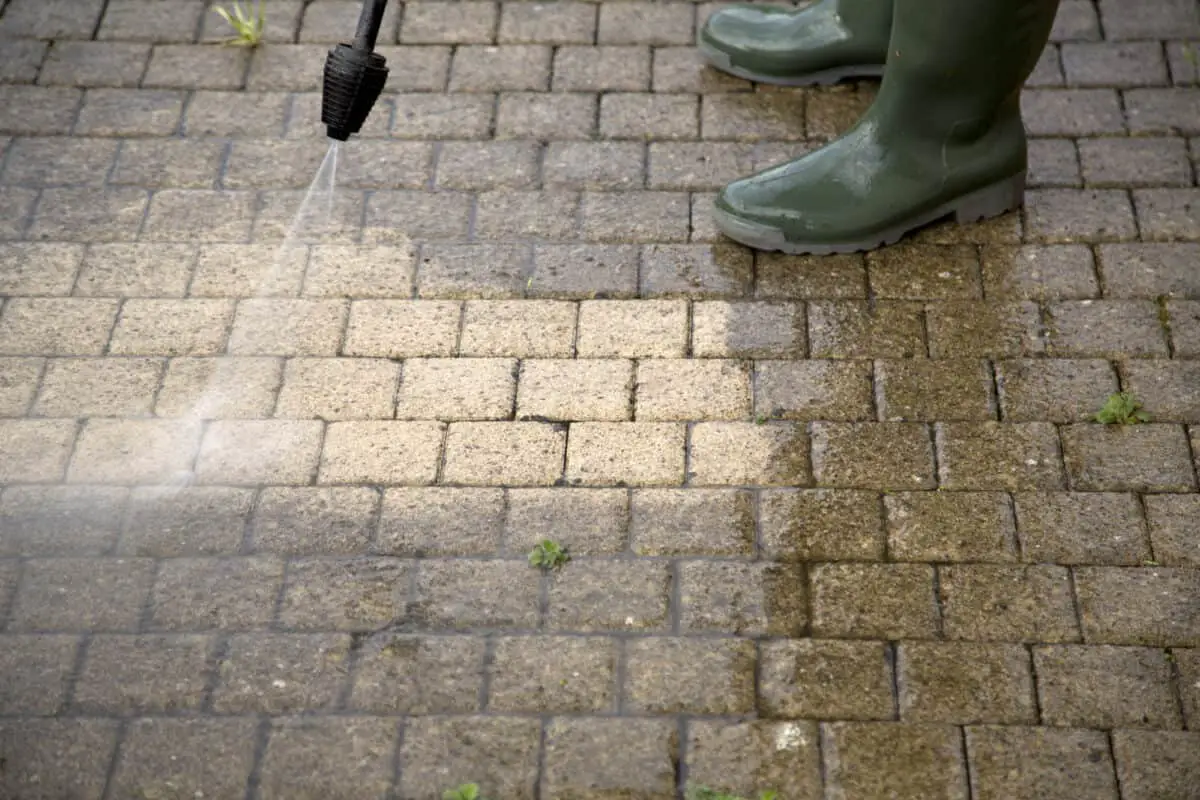Pressure washing concrete does not cause damage as long as there are no pre-existing cracks or holes. Cover any damages or avoid washing them, and avoid spraying too close to prevent visible pressure washer streaks.
Pressure washers are handy tools that can be used to wash some of the most challenging surfaces, but they may cause power washing damage. You do need to be very careful when washing certain types of materials.
Too often, homeowners go to their local hardware store to grab a pressure washer for cleaning jobs at home with little knowledge of how powerful the power washer is.
Some power washers are powerful enough to slice through a watermelon quickly. They can even cause serious damage to a person’s body, as well as power washing damage to concrete.
Whenever setting out to power wash a new surface, ensure you are using the proper settings, and following the right steps to avoid power washing damage on the surface, you’re trying to clean, like concrete.
Does using a pressure washer on concrete power washing damage?
Read on to find out some of the things you can and can’t wash with your pressure washer and how you would repair any power washing damage that may have occurred from pressure washing your concrete.

Table of Contents
Pressure Washing Concrete Frequency
The ideal timespan to pressure wash concrete is once every year; this should be done in the summer months, allowing the water to evaporate quickly.
Standing water can be bad for your concrete and can eventually start penetrating the surface and resting deep within the concrete.
It’s a good idea to wash your concrete once a year to keep it looking new and remove any grime, dirt, oil, or stubborn stains. Make sure to check your pressure washer regularly to ensure it hasn’t lost any pressure.
Pressure Washing Concrete Preparation
Before using a pressure washer on your concrete, it is essential to spray it with a degreaser and work it into the surface using a yard brush.
If you have a stubborn area, you can purchase pressure washer attachments for the wand.
These attachments feature hard-wearing bristles that enable both scrubbing and power washing, making them ideal for removing oil, grease, and grime.
You may need a pressure washer of a different size depending on the amount of concrete you need to use it for.
Related Reading: HOW TO PRESSURE WASH CONCRETE PATIOS, DRIVEWAYS & MORE
Removing Pressure Washer Streaks
When the operator holds the pressure washer wand too close to the surface, it can create lines in the concrete.
The residue left by pressure washing concrete is not harmful, but it can be unattractive.
To remove the streaks, apply muriatic acid on the affected area and scrub with a stiff brush.
The acid must be immediately neutralized with water to prevent damage to the concrete.
One method to eliminate water streaks is to sand the affected area in a circular motion with low-grit sandpaper.
It’s important to limit the use of this method to avoid causing damage. Always rinse the area with water after use.
Can I Use Bleach on Concrete?
It is safe to use bleach when pressure washing concrete, but avoid using it on painted concrete to prevent discoloration.
Bleach can effectively remove oil stains by pouring it on and using a stiff brush to scrub in a circular motion.
You should always use bleach in a well-ventilated area and rinse the area well afterward.
Be sure to wear appropriate personal protective gear when handling bleach to prevent harm to your health and clothing.
Precautions When Pressure Washing Damaged Concrete
If the concrete has already been damaged, pressure washing concrete may cause further harm over time, leading to brittleness, cracking, or crumbling.
Water settles among the very porous concrete beneath the surface.
During winter, water can freeze inside concrete, causing it to expand and stress the concrete, resulting in damage.
If an area has damage, cover it before pressure washing or avoid it altogether to prevent more damage.
Sealing Your Driveway
If you’re planning to pressure wash your concrete driveway, it’s recommended to seal the surface beforehand.
Sealing your driveway creates a protective barrier between the elements and the surface, which can help extend its lifespan up to 3-4 years.
If there is any damage to your driveway, the sealer will prevent water from penetrating the concrete.
Before sealing, ensure the area is clean, swept, and free of debris. Apply the sealer with a roller.
It is recommended to seal your driveway during the summer months and apply it before noon. This allows the sealer to dry over a couple of hours.
Use a paintbrush to get into corners and areas where the paint roller cannot get into.
It is recommended to re-seal your concrete every three years to prevent damage from pressure washing and the elements while keeping it clean.
Does Pressure Washing Damage Bricks and Pavers?
When pressure washing surfaces with mortar, take extra care to avoid damage.
Pressure washers, with their high PSI (1400-2300), can easily dislodge mortar and concrete from pavements and bricks.
To avoid damage, seal the mortar before washing or adjust the pressure washer nozzle to a fine spray.
You could also stand at least a couple of yards away from the area you are cleaning, again limiting the pressure.
When pressure washing surfaces like decks, follow these tips to minimize damage.
Related Reading: Best Pressure Washer Deck Cleaning Tips for Stellar Results
Conclusion
Pressure washing concrete is an effective way to maintain its appearance and prolong its lifespan.
You should avoid pressure washing any damaged areas, as it can cause further damage. These areas should be treated or avoided completely.
When pressure washing brick or paving, be careful around the mortar to avoid disruption or removal.
Whenever I pressure wash my concrete patio, I get immediate satisfaction from seeing the cleaning progress. I hope you will too!
Enjoy living the outdoor life!!!
